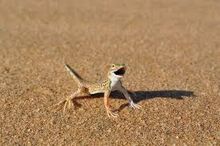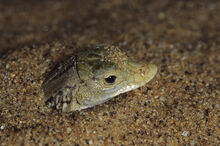(→Features: spelling mistake 'unusaul' to 'unusual') Tag: Visual edit |
No edit summary Tag: Source edit |
||
| (14 intermediate revisions by 9 users not shown) | |||
| Line 8: | Line 8: | ||
[[File:Amazing lizard dance & dive - Dune - BBC wildlife|thumb|480x480px]] |
[[File:Amazing lizard dance & dive - Dune - BBC wildlife|thumb|480x480px]] |
||
=== Habitat === |
=== Habitat === |
||
| − | The shovel-snouted lizard |
+ | The shovel-snouted lizard lives in the Namib Desert of southwestern Africa |
=== Features === |
=== Features === |
||
| Line 23: | Line 23: | ||
=== Appearance === |
=== Appearance === |
||
| − | An upper sand- |
+ | An upper sand-colored body with an arrangement of black marks that reach to the limbs. The head is paler than the body and emits a silvery sheen. |
=== Breeding === |
=== Breeding === |
||
| − | Shovel |
+ | Shovel snouted lizards defend their territory vigorously high into the reproductive season. Luckily for them there is no fixed breeding season either and eggs are laid at regular intervals, peaking during December to March. Females lay a single egg in a small chamber that has been dug firmly into the sand |
=== === |
=== === |
||
Latest revision as of 18:42, 22 May 2021








Amazing lizard dance & dive - Dune - BBC wildlife
Habitat[]
The shovel-snouted lizard lives in the Namib Desert of southwestern Africa
Features[]
It has an unusual flattened snout with a cutting edge and nostrils that point upwards, as well as enlarged feet that allow it to dash across the sand at high speed without sinking into the dunes.
Although they can withstand temperatures of up to 44 degrees Celsius, they perform a characteristic 'thermal dance' to avoid overheating, balancing on their tail & lifting two of their feet every 10 seconds to cool them.
When the shovel-snouted lizard is alarmed it dives into the dune slip-face. It will then swim as deep as need be to escape any danger, but will raise its body to jump and bite if necessary to protect itself if the hazard continues. It will also dive down if the surface temperature is too high, and can survive for 24 hours buried down under using air trapped in the sand. The streamlined shape of its nose helps it to penetrate the sand.
It also has a special water bladder, a blind tube branching off from its intestine. There it stores a large reserve of water, obtained by drinking when fog settles on cold nights along the coast of Namibia.
Diet[]
Small beetles and insects and in times of desert famine they will eat seeds. All of their moisture requirements are obtained from food.
Appearance[]
An upper sand-colored body with an arrangement of black marks that reach to the limbs. The head is paler than the body and emits a silvery sheen.
Breeding[]
Shovel snouted lizards defend their territory vigorously high into the reproductive season. Luckily for them there is no fixed breeding season either and eggs are laid at regular intervals, peaking during December to March. Females lay a single egg in a small chamber that has been dug firmly into the sand